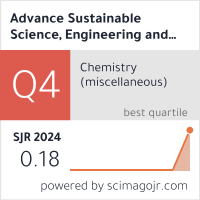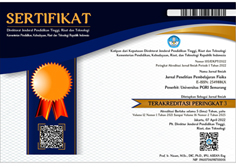Assessing the Feasibility of Small-Scale RDF Technology in Urban Solid Waste Management Using Cost-Benefit Analysis
DOI:
https://doi.org/10.26877/asset.v7i3.1988Keywords:
Cost Benefit Analysis, Refuse Derived Fuel, Solid Waste Management, TPS 3RAbstract
The development of Waste Processing Facilities based on the 3R principles (TPS 3R) with small-scale Refuse Derived Fuel (RDF) technology in Jakarta aims to support waste sorting, composting, reuse, and recycling activities, with locations strategically placed as close as possible to service areas. However, its implementation faces significant challenges, particularly due to high initial investment and operational costs. This study evaluates the feasibility of four TPS 3R facilities using a Cost-Benefit Analysis approach, considering economic, environmental, and social dimensions. The results indicate that all units are economically viable, with TPS 3R Joe demonstrating the highest economic feasibility, marked by a BCR of 1.870, an NPV of IDR 25.81 billion (USD 1.60 million), and an IRR of 15.76%. The study concludes that the successful implementation of small-scale RDF technology is highly influenced by technical efficiency, institutional support, community participation, and policies that are adaptive to local characteristics.
References
[1] K. D. Sharma and S. Jain, ‘Municipal solid waste generation, composition, and management: the global scenario’, Soc. Responsib. J., vol. 16, no. 6, pp. 917–948, Jun. 2020, doi: 10.1108/SRJ-06-2019-0210.
[2] UNEP, Ed., Beyond an age of waste: turning rubbish into a resource. in Global waste management outlook, no. 2024. Nairobi: UNEP, 2024.
[3] E. A. Wikurendra, A. Csonka, I. Nagy, and G. Nurika, ‘Urbanization and Benefit of Integration Circular Economy into Waste Management in Indonesia: A Review’, Circ. Econ. Sustain., vol. 4, no. 2, pp. 1219–1248, Jun. 2024, doi: 10.1007/s43615-024-00346-w.
[4] Y. A. Fatimah, K. Govindan, R. Murniningsih, and A. Setiawan, ‘Industry 4.0 based sustainable circular economy approach for smart waste management system to achieve sustainable development goals: A case study of Indonesia’, J. Clean. Prod., vol. 269, p. 122263, Oct. 2020, doi: 10.1016/j.jclepro.2020.122263.
[5] F. Melakessou, P. Kugener, N. Alnaffakh, S. Faye, and D. Khadraoui, ‘Heterogeneous Sensing Data Analysis for Commercial Waste Collection’, Sensors, vol. 20, no. 4, p. 978, Feb. 2020, doi: 10.3390/s20040978.
[6] L. Zhang et al., ‘The reduction of the carbon footprint of municipal solid waste management via source classification and supporting strategies: An analysis for the megacity of Shenzhen’, Waste Manag., vol. 187, pp. 145–155, Oct. 2024, doi: 10.1016/j.wasman.2024.07.012.
[7] I. W. K. Suryawan and C.-H. Lee, ‘Achieving zero waste for landfills by employing adaptive municipal solid waste management services’, Ecol. Indic., vol. 165, p. 112191, Aug. 2024, doi: 10.1016/j.ecolind.2024.112191.
[8] H. Rezaei, F. Yazdan Panah, C. J. Lim, and S. Sokhansanj, ‘Pelletization of Refuse-Derived Fuel with Varying Compositions of Plastic, Paper, Organic and Wood’, Sustainability, vol. 12, no. 11, p. 4645, Jun. 2020, doi: 10.3390/su12114645.
[9] M. Stričík, L. Kuhnová, M. Variny, P. Szaryszová, B. Kršák, and Ľ. Štrba, ‘An Opportunity for Coal Thermal Power Plants Facing Phase-Out: Case of the Power Plant Vojany (Slovakia)’, Energies, vol. 17, no. 3, p. 585, Jan. 2024, doi: 10.3390/en17030585.
[10] Wiharja et al., ‘Research on the matching relationship of municipal solid waste management and alternative fuel in Indonesia’s cement industry’, Case Stud. Chem. Environ. Eng., vol. 11, p. 101098, Jun. 2025, doi: 10.1016/j.cscee.2025.101098.
[11] J. A. M. Chavando, V. B. Silva, L. A. C. Tarelho, J. S. Cardoso, and D. Eusébio, ‘Snapshot review of refuse-derived fuels’, Util. Policy, vol. 74, p. 101316, Feb. 2022, doi: 10.1016/j.jup.2021.101316.
[12] A. Siddiqi, M. Haraguchi, and V. Narayanamurti, ‘Urban waste to energy recovery assessment simulations for developing countries’, World Dev., vol. 131, p. 104949, Jul. 2020, doi: 10.1016/j.worlddev.2020.104949.
[13] A. H. Khan et al., ‘Evaluation of cost benefit analysis of municipal solid waste management systems’, J. King Saud Univ. - Sci., vol. 34, no. 4, p. 101997, Jun. 2022, doi: 10.1016/j.jksus.2022.101997.
[14] C. Ghinea and M. Gavrilescu, ‘Costs Analysis of Municipal Solid Waste Management Scenarios: Iasi – Romania Case Study’, J. Environ. Eng. Landsc. Manag., vol. 24(3), pp. 185–199, 2016, doi: https://doi.org/10.3846/16486897.2012.721784.
[15] T. Jamasb and R. Nepal, ‘Issues and options in waste management: A social cost–benefit analysis of waste-to-energy in the UK’, Resour. Conserv. Recycl., vol. 54, no. 12, pp. 1341–1352, Oct. 2010, doi: 10.1016/j.resconrec.2010.05.004.
[16] G. De Lorena Diniz Chaves, R. R. Siman, G. M. Ribeiro, and N.-B. Chang, ‘Synergizing environmental, social, and economic sustainability factors for refuse derived fuel use in cement industry: A case study in Espirito Santo, Brazil’, J. Environ. Manage., vol. 288, p. 112401, Jun. 2021, doi: 10.1016/j.jenvman.2021.112401.
[17] D. Prihandoko, C. W. Purnomo, P. K. Widyaputra, and N. Nasirudin, ‘Application of Refuse-Derived Fuel (RDF) Plant in Piyungan Landfill Municipal Solid Waste Management’, ASEAN J. Chem. Eng., vol. 22, no. 2, p. 296, Dec. 2022, doi: 10.22146/ajche.75560.
[18] B. H. M. Zahir, R. Nurcahyo, Farizal, and A. D. Wibowo, ‘ECONOMIC ASSESSMENT OF REFUSE-DERIVED FUEL (RDF) PRODUCTION AS WASTE MANAGEMENT STRATEGY AND ALTERNATIVE FUEL IN CEMENT KILNS’, J. Law Sustain. Dev., vol. 12, no. 2, p. e3220, Feb. 2024, doi: 10.55908/sdgs.v12i2.3220.
[19] G. Squires, Urban and Environmental Economics: An Introduction, 1st ed. Routledge, 2012. doi: 10.4324/9780203825990.
[20] G. Shively, ‘An Overview of Benefit-Cost Analysis’, Jan. 2012.
[21] A. T. Hoang et al., ‘Perspective review on Municipal Solid Waste-to-energy route: Characteristics, management strategy, and role in circular economy’, J. Clean. Prod., vol. 359, p. 131897, Jul. 2022, doi: 10.1016/j.jclepro.2022.131897.
[22] P. Damayanti, S. S. Moersidik, and J. T. Haryanto, ‘Waste to Energy in Sunter, Jakarta, Indonesia: Plans and Challenges’, IOP Conf. Ser. Earth Environ. Sci., vol. 940, no. 1, p. 012033, Dec. 2021, doi: 10.1088/1755-1315/940/1/012033.
[23] H. A. M. Salman, ‘Optimizing Biomass Pre-Treatment Technologies for BBJP Plants in Indonesia: A Multi-Criteria Decision Making Approach’, Adv. Sustain. Sci. Eng. Technol., vol. 6, no. 1, p. 02401021, Jan. 2024, doi: 10.26877/asset.v6i1.17877.
[24] M. Zulhusni, C. A. Sari, and E. H. Rachmawanto, ‘Implementation of DenseNet121 Architecture for Waste Type Classification’, Adv. Sustain. Sci. Eng. Technol., vol. 6, no. 3, p. 02403015, Jul. 2024, doi: 10.26877/asset.v6i3.673.
[25] M. R. Ismiraj, A. Wulansari, Y. Setiadi, A. Pratama, and N. Mayasari, ‘Perceptions of Community-Based Waste Bank Operators and Customers on Its Establishment and Operationalization: Cases in Pangandaran, Indonesia’, Sustainability, vol. 15, no. 14, p. 11052, Jul. 2023, doi: 10.3390/su151411052.
[26] G. Gadaleta, S. De Gisi, F. Todaro, G. D’Alessandro, S. Binetti, and M. Notarnicola, ‘Assessing the Sorting Efficiency of Plastic Packaging Waste in an Italian Material Recovery Facility: Current and Upgraded Configuration’, Recycling, vol. 8, no. 1, p. 25, Feb. 2023, doi: 10.3390/recycling8010025.
[27] A. S. Bello, M. A. Al-Ghouti, and M. H. Abu-Dieyeh, ‘Sustainable and long-term management of municipal solid waste: A review’, Bioresour. Technol. Rep., vol. 18, p. 101067, Jun. 2022, doi: 10.1016/j.biteb.2022.101067.
[28] B. H. Dastjerdi, V. Strezov, R. Kumar, and M. Behnia, ‘Economic Feasibility and Sustainability Assessment of Residual Municipal Solid Waste Management Scenarios in NSW, Australia’, Sustainability, vol. 13, no. 16, p. 8972, Aug. 2021, doi: 10.3390/su13168972.
[29] R. Prateep Na Talang and S. Sirivithayapakorn, ‘Comparative analysis of environmental costs, economic return and social impact of national-level municipal solid waste management schemes in Thailand’, J. Clean. Prod., vol. 343, p. 131017, Apr. 2022, doi: 10.1016/j.jclepro.2022.131017.
[30] W. Ahmad et al., ‘Socio-economic benefits and policy implications of generating sustainable energy from municipal solid waste in Pakistan’, Energy Clim. Change, vol. 5, p. 100124, Dec. 2024, doi: 10.1016/j.egycc.2023.100124.
[31] M. Struk and M. Boďa, ‘Factors influencing performance in municipal solid waste management – A case study of Czech municipalities’, Waste Manag., vol. 139, pp. 227–249, Feb. 2022, doi: 10.1016/j.wasman.2021.09.022.
[32] F. M. Tsai, T.-D. Bui, M.-L. Tseng, K.-J. Wu, and A. Sf. Chiu, ‘A performance assessment approach for integrated solid waste management using a sustainable balanced scorecard approach’, J. Clean. Prod., vol. 251, p. 119740, Apr. 2020, doi: 10.1016/j.jclepro.2019.119740.
[33] W. Sidiq, T. Sanjoto, and A. Jabbar, ‘Assessing Environmental Quality Using the Risk Screening Environmental Indicators (RSEI) Method: A Multi-Year Remote Sensing Approach’, Adv. Sustain. Sci. Eng. Technol., vol. 7, p. 0250302, May 2025, doi: 10.26877/pf84qe16.
[34] A. H. Khan et al., ‘Municipal solid waste generation and the current state of waste-to-energy potential: State of art review’, Energy Convers. Manag., vol. 267, p. 115905, Sep. 2022, doi: 10.1016/j.enconman.2022.115905.
[35] S. Mor and K. Ravindra, ‘Municipal solid waste landfills in lower- and middle-income countries: Environmental impacts, challenges and sustainable management practices’, Process Saf. Environ. Prot., vol. 174, pp. 510–530, Jun. 2023, doi: 10.1016/j.psep.2023.04.014.
[36] T. T. Y. Anh, S. Herat, and K. Prasad, ‘A Review on Extended Producer Responsibility Schemes for Packaging Waste Management and Research Gaps in the Field’, Nat. Environ. Pollut. Technol., vol. 24, no. 1, p. D1662, Mar. 2025, doi: 10.46488/NEPT.2025.v24i01.D1662.
[37] V. Arsanti et al., ‘Spatial Analysis of Waste Management Facility Distribution Using GIS’, Adv. Sustain. Sci. Eng. Technol., vol. 6, no. 4, p. 02404013, Sep. 2024, doi: 10.26877/asset.v6i4.996.
[38] M. Labambe, ‘Predicting Waste Production Trends in Palu City Using Linear Regression Analysis’, Adv. Sustain. Sci. Eng. Technol., vol. 6, no. 3, p. 0240306, Jun. 2024, doi: 10.26877/asset.v6i3.523.
[39] S. Purwati, ‘Evaluating Sustainable Waste Collection Models Using the Analytical Hierarchy Process (AHP): A Multi-Criteria Decision-Making Approach’, Adv. Sustain. Sci. Eng. Technol., vol. 7, p. 0250305, May 2025, doi: 10.26877/25x2jy26.
[40] D. I. Setyanansyach, M. Setiyo, and T. Raja, ‘Review and Bibliometric Analysis of Biogas Power Plants in Indonesia’, Adv. Sustain. Sci. Eng. Technol., vol. 5, no. 3, p. 02303015, Oct. 2023, doi: 10.26877/asset.v5i3.16806.











